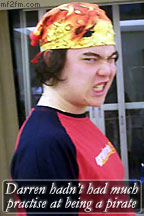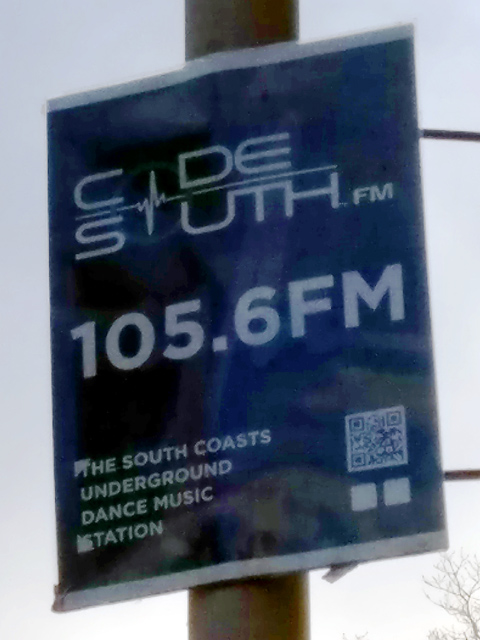 Back in 2008, Wireless Waffle discussed the fact that the licensing of new community radio stations by Ofcom had forced many pirate radio stations to change frequency and in some cases to move to using two (or more) frequencies simultaneously in order to provide wide area coverage without treading on the toes of officially licensed stations.
Back in 2008, Wireless Waffle discussed the fact that the licensing of new community radio stations by Ofcom had forced many pirate radio stations to change frequency and in some cases to move to using two (or more) frequencies simultaneously in order to provide wide area coverage without treading on the toes of officially licensed stations. As the number of community stations continues to grow, the problem of finding a 'clear' frequency for the pirates to operate on becomes increasingly difficult. Indeed, one might even go so far as to suggest that part of the reason for Ofcom's relatively newly found interest in licensing community radio stations is to purposefully force pirates off the airwaves, which would, of course, be in perfect alignment with their objectives as the regulator of the radio spectrum.
For many years Ofcom claimed that there were no FM frequencies available for new radio stations as the band was full, but over the past 10 years or so, they have licensed dozens of community stations all over the country. Being lower power and covering a smaller area they have managed to squeeze a number of stations into a band which had been previously claimed to have no space in it. What is interesting is how similar the frequencies chosen by Ofcom for the community stations are to those that were previously employed by the pirates themselves, suggesting that the frequencies that the pirates were using were well chosen so as to try and avoid causing interference to legitimate stations.
Take, for example, the handful of radio pirates operating in Brighton on the south coast of the UK. The table below shows some of the frequencies used by pirates in the area, and the frequencies used by the four community stations now broadcasting to the city. You will note that there is a large degree of commonality.
| Pirate Station | Frequency | Community Station | Frequency |
|---|---|---|---|
| InFront FM Haven976 | 97.9 97.6 | Gaydio | 97.8 |
| Radio 4A | 101.4 | 1BTN | 101.4 |
| CodeSouth FM | 105.6 | Platform B | 105.5 |
| - | - | Radio Reverb | 97.2 |
 One station, CodeSouth, has changed frequency four times since it first went on air in 2012. Initialy on 108.0, it moved to 88.8 in 2013, then to 98.5 (the frequency previously used by another Brighton pirate 'FIP') from 2014 to 2015, then to 105.6 until late 2018 and is currently on 88.2 MHz. Incidentally, the choice of 88.2 MHz may not be the best, as it is the frequency used by a low-power relay of BBC Radio 2 in nearby Bexhill. Though the relay does not put a strong signal into Brighton and thus the frequency may appear empty, the same may not be true of CodeSouth's big signal heading in the opposite direction (88.0 may have been a better choice). Of course there are a decreasing number of frequencies available and any choice is likely to cause potential interference to someone.
One station, CodeSouth, has changed frequency four times since it first went on air in 2012. Initialy on 108.0, it moved to 88.8 in 2013, then to 98.5 (the frequency previously used by another Brighton pirate 'FIP') from 2014 to 2015, then to 105.6 until late 2018 and is currently on 88.2 MHz. Incidentally, the choice of 88.2 MHz may not be the best, as it is the frequency used by a low-power relay of BBC Radio 2 in nearby Bexhill. Though the relay does not put a strong signal into Brighton and thus the frequency may appear empty, the same may not be true of CodeSouth's big signal heading in the opposite direction (88.0 may have been a better choice). Of course there are a decreasing number of frequencies available and any choice is likely to cause potential interference to someone. The other pirate stations have not been heard of for some time. It seems at least partially feasible that some of the presenters have found their way onto one of the new community stations and as such there is no longer a need for them to fly the jolly radio roger. In this respect, it could be argued that Ofcom's community radio policy has had a double whammy effect and both taken away the frequencies from the pirates, and taken away the needs of the DJ's to use pirate stations as an outlet for their music.
 Despite all the above, the simplicity of Internet streaming (which many of the pirates also do) and the opportunity of space on local DAB multiplexes, the UK's licensing laws must still be failing some part of the musical community, otherwise there would no longer be a need for the pirates. The whole situation sounds hugely reminiscent of the very early days of the pirates, when the BBC launched Radio 1 to try and take away the need for the offshore stations playing 'pop' music, yet the pirates persevered. What will it take to finally find a way to end unlicensed broadcasting, and give everyone who wishes to have a radio show the audience they seek?
Despite all the above, the simplicity of Internet streaming (which many of the pirates also do) and the opportunity of space on local DAB multiplexes, the UK's licensing laws must still be failing some part of the musical community, otherwise there would no longer be a need for the pirates. The whole situation sounds hugely reminiscent of the very early days of the pirates, when the BBC launched Radio 1 to try and take away the need for the offshore stations playing 'pop' music, yet the pirates persevered. What will it take to finally find a way to end unlicensed broadcasting, and give everyone who wishes to have a radio show the audience they seek?add comment
( 1283 views )
| permalink
| 



 ( 3 / 91883 )
( 3 / 91883 )




 ( 3 / 91883 )
( 3 / 91883 )

